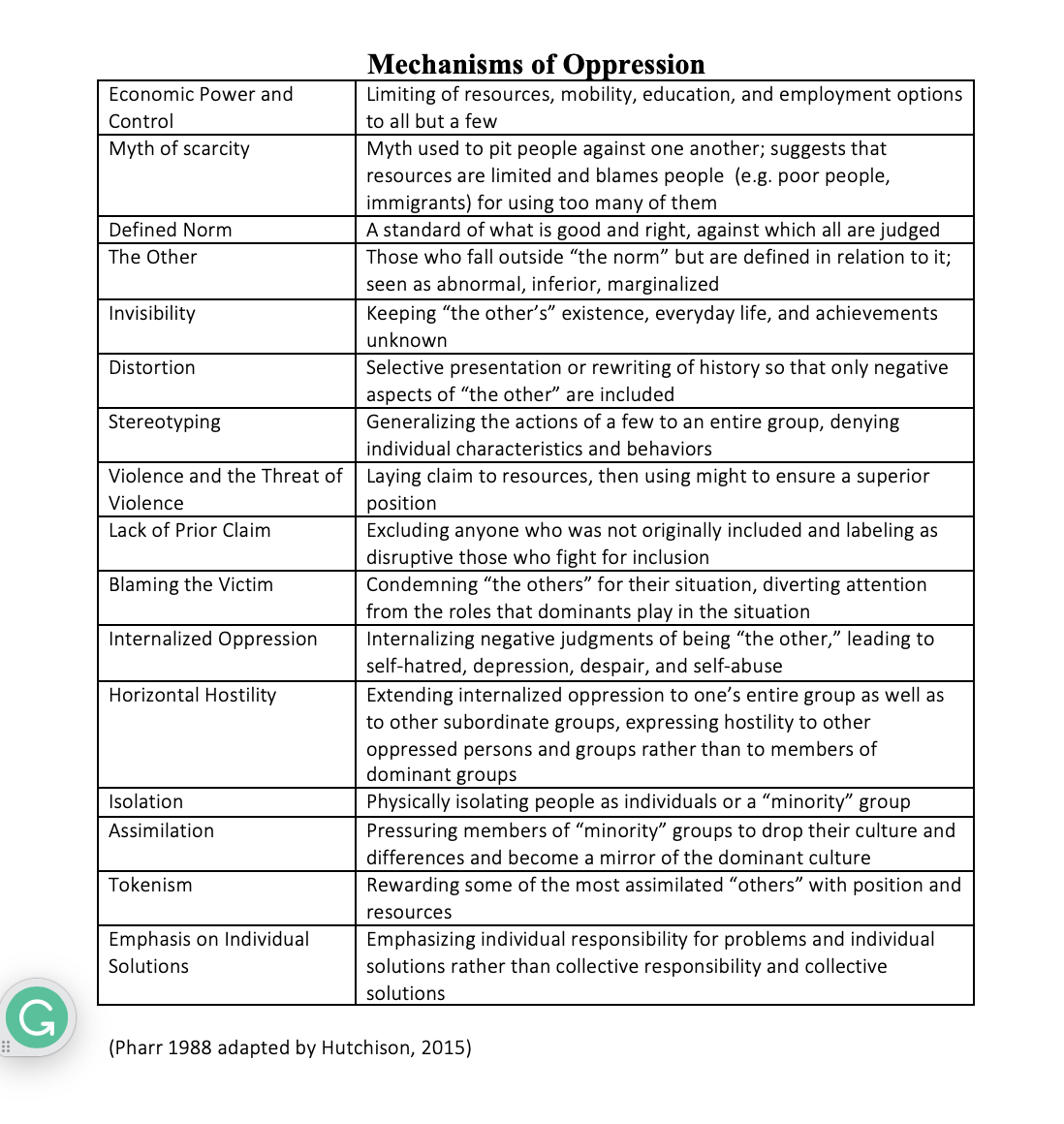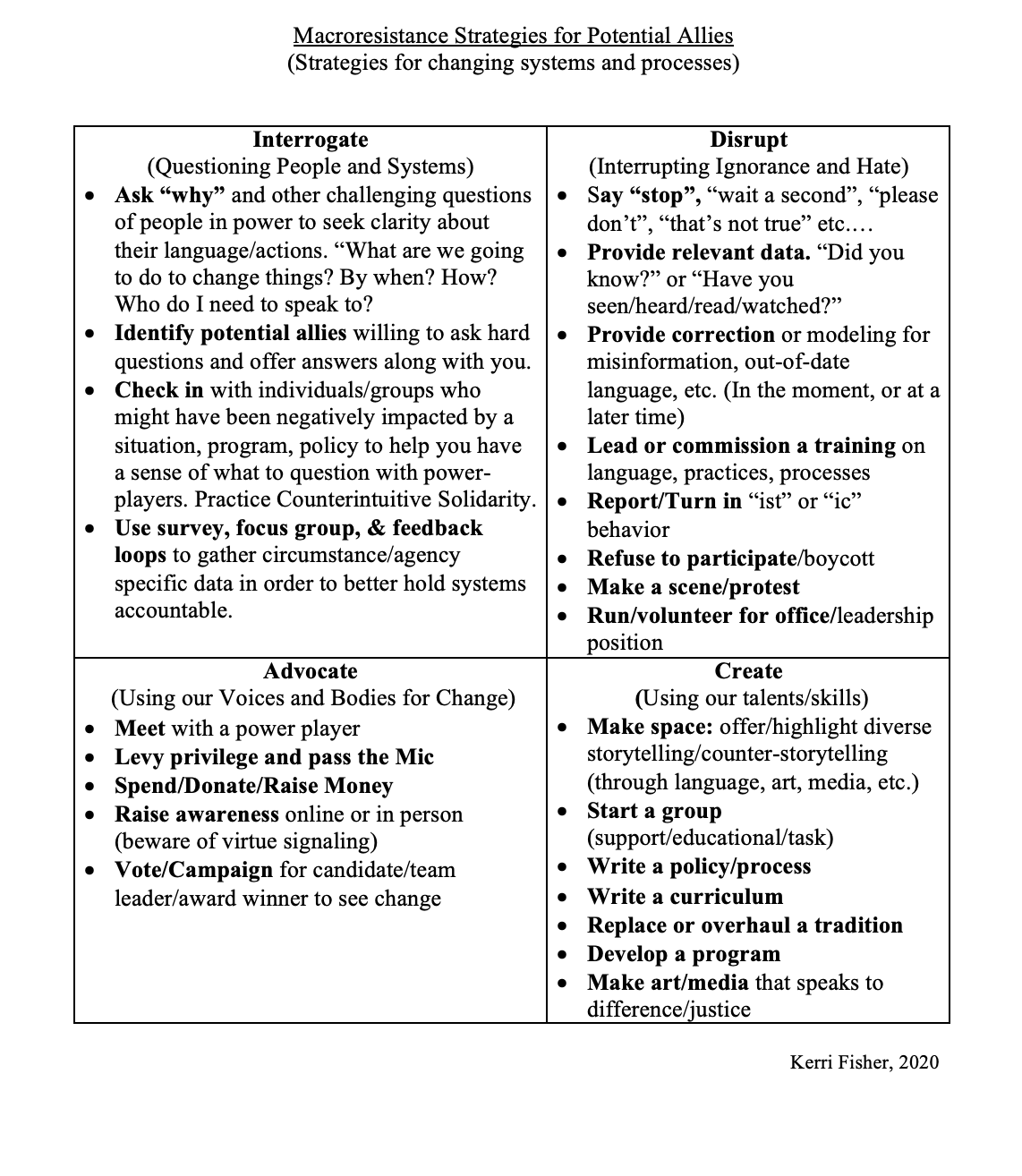Miller, J. & Garran, A.M. (2007) The Web of Institutional Racism, Smith College Studies in Social Work, 77:1, 33-67, DOI: 10.1300/J497v77n01_03
4 Chapter 4: Institutional Structures, Mechanisms of Oppression, & Macroresistance

Think of a time when you first understood that a policy or process was unfair and/or unmanageable for you or someone you care about.
- What do you think were the reasons the policy or process was created or maintained if it wasn’t working for everyone?
- What did you think/feel/say/do at the time?
- Is there anything you would have wanted to do differently if given another opportunity?
Definitions and Examples
Institutions/Institutional Systems: This text will alternate between the terms institution, organization, and system to describe the major cultural entities that create and contribute to the overall life outcomes of individuals from various intersectional identities. Below are nine central institutions in any given society as defined/described by Miller and Garran (2011). Read the definitions and click on the links provided to examine some of the disparities/disproportional outcomes in each area in recent years.
Institutions/Systems:
- Residential System: Programs, policies, and processes that create access and/or barriers to neighborhoods and housing.
- Examples: Opportunity Starts at Home, 2022; National Association of Realtors Apology, 2020
- Educational System: Programs, policies, and processes that create access or barriers to public and private, elementary school, secondary school and/or higher education
- Examples: Children at Risk Report (Texas), 2023
- Employment/Economics Systems: Programs, policies, and processes that create access or barriers to interviews, hiring, promotion, pay, wealth accumulation, & upward mobility.
- Examples: National Fund for Workforce Solutions, 2022
- Healthcare/Environmental Systems: Programs, policies, and processes that create access or barriers to clean air, insulation from natural disasters, and/or preventative and restorative medical intervention.
- Examples: American Progress, 2020.
- Mental Health System: Programs, policies, and processes that create access and/or barriers to qualified, representative, culturally aware, specialized, therapy, case management, and crisis intervention.
- Examples: Psychiatry.org, 2022
- Carceral System: Programs, policies, and processes that create access and/or barriers to fair sentencing in terms of type, length, and intensity of legal punishment.
- Example: Prison Policy, 2022
- Politics: Programs, policies, and processes that create access and/or barriers to governmental representation.
- Examples: Pew Research, 2022
- Media: Programs, policies, and processes that create access and/or barriers to fair representation in journalism, art, and societal communication.
- Examples: Geena Davis Institute, 2022; GLAAD Report, 2023
Elements/Mechanisms of Oppression
Suzanne Pharr first described a collection of oppressive elements in her 1989 book Homophobia: a weapon of Sexism. Elizabeth Hutchison (2015) later adapted the elements and renamed them “Mechanisms of Oppression”. The sixteen adapted definitions are below.

Take a moment and try to think of an example of each mechanism of oppression in your life or in recent news/popular culture. Which do you feel most comfortable explaining to someone else? Which, if any, are still a bit confusing? The author of this text has created four categories of macroresistance that self-advocates and aspiring allies can use to intervene in systems where mechanisms of oppression are being used to create and/or continue inequity.
Macroresistance Strategies

Fisher, 2021
Looking at the chart above, how many of these resistance strategies have you tried? Which of them seem the most natural to you? Which could be a “comfortably uncomfortable” opportunity for you to try in the future?
References
Daftary, A. M. H. (2018). Critical race theory: An effective framework for social work research. Journal of Ethnic &
Cultural Diversity in Social Work, 29(9), 439-454. https://doi.org/10.1080/15313204.2018.1534223
Fisher, K. (2021). An experiential model for cultivating cultural humility and embodying antiracist action in and outside the social work classroom. Advances in
Social Work 21(2/3), 690-707. https://doi.org/10.18060/24184
Pharr, S. (1988). Homophobia: A weapon of sexism. Chardon Press.